9 July, 1978, 0415 hours, Privolzhskiy Airbase [PVO], Azerbaijan, USSR:
Crap! It was early, thought 2nd Lieutenant Sergei Ivanovich Nikolayev, as he yawned..."Attention! Rise for the squadron commander and unit commisar!" The commisar, Major K. Pavlov, strode confidently into the briefing room, followed close behind by the considerably more haggard looking squadron commander, Major Ivan K. Smirnov. Boy! He must have had a long night answering the unending questions on the loyalty of his personnel. The increased late night investigations and scrutiny had started about two years ago...Sergei had heard whispered rumors of a MiG-25 being stolen by an "enemy of the people", a defector who had flown the priceless jet to the USSR's Capitalist enemies. No matter, he was here now, a new 2LT in a Voyska Protivovozdushnoy Oborony (PVO) unit flying the Su-11 interceptor. He was happy to escape his cares on the ground and go chase the clouds, preparing for what he hoped would never come: A nuclear attack by the American's B-52s. He wondered: Were the American Air Force pilots like him? Were they aviators at heart who loved their country, just as he? Were they just doing their jobs and hoping the worst never came? He was confident, though, that the "SAC Warriors" would be determined, skilled and aggressive in pressing their attacks. I hope the politicians don't screw this up and start a nuclear war, though Sergei; but if they did, he would be there ready to fire those two enormous K-98 missiles and then ram a second bomber, flying into the cockpit to destroy it rather than landing back at a base that likely wouldn't even be there in an irradiated, lifeless ash heap following a nuclear exchange. For Mother Russia!

Smirnov was briefing the day's mission: "You will be conducting an interception of a Tu-95 simulating an American B-52 and will be under GCI [Ground Controlled Intercept]. Just fly the headings, speeds and throttle settings they give you and fire when ordered." His eyes flitting momentarily towards K. Pavlov..."Don't deviate from directions! Understood?" Smirnov was a good commander, he took care of his men, but the unrelenting pressure of running a unit with that jerk Pavlov scrutinizing his every move had to be crushing. All his unit's men had to say the right things, be unswervingly loyal to the revolutionary ideals...even THINK the right thoughts. Enemies were everywhere! It must be exhausting! Sergei wondered if Ivan would, if given a chance, run for Turkey if he didn't have a wife and children he would have to leave behind, like that MiG-25 pilot had. He pushed the thought out of his mind. It would be too difficult, even the radios were preprogrammed with only the few frequencies needed to conduct training. "Attention! Get suited up! We will walk to the jets in 30 minutes!"
Credits: BogdanX and EternalDarkness for flight testing and evaluation. FairFireFight for the glorious R-98 missiles! B-52 by TawyOwl...Thud by me. Thanks to all my friends at SPMC for general encouragement and help!
Features:

Working Mach and G meters. The Mach meter is accurate and assumes standard day conditions (15 degrees C at S.L. and -2 degrees/1000' lapse rate).
Mach effects have been incorporated for both the shock cone, which operates between Mach 1.5 - 2.2, as well as reduced turn rates when flying in excess of Mach 1.0.
Buffeting has been incorporated with increasing angles of attack. Light buffet is good, heavy buffet is bad (read notes below).
1:1 scale, accurate weights, fuel quantity, performance (Mach 2.2 at 41,000' / 12500 meters), turn capability with energy loss, accurate maximum ceiling (mid-60,000' / 19,800 meters), takeoff and landing distances and weaponry.
Controls:

Standard pitch, roll and yaw. Yaw also controls nosewheel steering on ground below 55 knots / 28 m/s.
AG1 - Nav & Landing Lights (Deploy with LG)
AG2 - Radar
AG3 - Jettison Drop Tanks
AG4 - Drag Chute
AG5 - Speedbrake (Brake will also activate SBs)
AG6 - Jettison Missiles
AG7 - Open
AG8 - Reserved
Brake - Speedbrakes and wheel brakes
VTOL - Flaps
Trim - Trim
Flight Manual:
Takeoff:

- Set takeoff trim (1/2 notch down), flaps above first detent for takeoff flaps.
- Apply MAX power (AB lights at 99% RPM).
- Begin to apply back stick pressure at 200 KIAS / 370 kph indicated, rotate to approximately 5 degrees nose high.
- Jet should fly off at 210 KIAS / 390 kph indicated.
- Retract landing gear immediately once safely away.
WARNING: Ensure aircraft is safely away with a positive rate of climb prior to raising landing gear. Do not allow aircraft to settle into runway just after liftoff.
NOTE: Slightly releasing back stick pressure and trimming nose down slightly once safely airborne to reduce the angle of attack and induced drag will increase acceleration rates following takeoff. Do not allow the aircraft to settle back into the runway.
Ivan Says: "Comrade! This aircraft has a symmetric wing...you can feel the maximum turn performance on the light buffet and see the light shaking on the instrument panel. But, pull too hard on the stick and the jet will buffet heavily, resulting in unacceptable airspeed loss, which not only waste's the People's jet fuel, it can result in a stall during landing approach or getting your mount shot out from underneath you by a NATO Phantom. Pull hard enough to get to the tickle, but avoid the heavy buffet!"
Maximum Load Limitation: +7 G.
Maximum Speed Limitation: Mach 2.2, though aircraft is capable of exceeding this speed.
CAUTION: Pilot attention is required to prevent airspeed exceedance when flying at high Mach numbers at high altitude, especially when clean.

Flight Characteristics:
With the big delta wing, the initial rate of turn is extremely good for the first 180 degrees ("bat turn"), but energy loss is very high at increased angles of attack and/or G loads in excess of 5 Gs. Use of afterburner is required to sustain best rates of turn for as long as possible and a tradeoff of altitude may be required to minimize speed loss.
Best acceleration is achieved by “unloading”—relaxing back stick pressure slightly to 1/2 G, lowering the angle of attack and induced drag. Useful in all phases of flight when best acceleration is required and during combat engagements.
Best initial rates of turn are achieved at high indicated airspeeds, but less than Mach 1.0 and on the "tickle".
CAUTION: When slowing below Mach 1.0, turn rate and G loading will increase abruptly during the transition, use caution to prevent exceeding maximum load factors (+7 G).
If attempting to slow the aircraft, a turn at increased G is very effective to slow. The speedbrakes are also very effective in slowing the aircraft.
Aileron forces are light and roll rate is very good with power boosted controls in all 3 axes. Rudder is effective for rolling the aircraft and may be preferable in place of using ailerons when rolling at very high angles of attack.
Airbrakes are extremely effective.

Tactics:
The R-98 MR (Semi-Active Radar Guided) and R-98 MT (Infrared Guided) missiles are designed to emulate the frustration Su-11 pilots must have felt being constrained by strict, controlling GCI instructions and also have a narrow Field of View (FoV), just like RL. Soviet doctrine emphasized following ground instructions and firing both missiles at a single target, the MR first, followed closely by the MT. Should the missiles miss, accepted Soviet tactics included ramming the target, which was quite common during WWII.
Otherwise, the Su-11 is optimized for high altitude, high speed flight. The Mach meter is accurate and will help monitor your maximum Mach of 2.2 and preferred interception profiles included a rapid climb to the mid-20,000' regime, accelerating above Mach 1.0, then climbing up to 40,000'+ and accelerating to maximum airspeed.
The missiles are large, heavy and draggy...they will limit aircraft performance significantly, just as they did IRL, which must have also been frustrating for Su-11 pilots. The jet flies much better once they are fired.
Approach and Landing:
Slow below 250 KIAS / 460 kph indicated airspeed prior to extending landing gear. Lower flaps to full. Slow to no slower than 160 KIAS / 300 kph indicated airspeed on final (faster if heavy with fuel and stores), approximately 65% RPM. Approach should be flown "on the tickle"...the instrument panel will lightly shake. Approaching the underrun, reduce power to idle (0% RPM) and flare slightly. Just as IRL, a little extra speed may be required to smooth the touchdown. Deploy drag chute (AG4) as required to reduce landing roll.

WARNING: Allowing aircraft to slow excessively on final will lead to a high sink rate and impending stalled condition. Simply pulling back on the stick will only aggravate a shallow, low glide path. Add power, accelerate and slightly reduce AoA if necessary, to correct glide path. If not corrected, a stall accompanied by wing roll off in excess of 60 degrees is possible. Should an approach stall accompanied by roll off be encountered, aileron WILL aggravate the adverse roll, correct the situation by simultaneously relaxing back stick pressure to lower the angle of attack below the critical AoA, advancing the throttle to MAX power, rolling to wings level using a combination of rudder and ailerons and arresting the sink rate.
CAUTION: Allowing aircraft to slow excessively on short final will lead to a dropped in landing, sometimes accompanied by a bounce and possible aircraft damage. If encountering a bounce, release a small amount of back stick pressure to arrest the height above the runway and arrest the sink rate just prior to re-contacting the runway. Do not allow the nose to contact the runway surface first.
Ivan Says: "Comrade! In order to land on speed, you must fly final "on the tickle"...observe the instrument panel lightly shaking. However, fly any slower and getting to the heavy, low frequency buffett which indicates a stalled condition, will kill you! Unless you want a State funeral, the Order of the Red Star and your family to receive a middling pension for the rest of their lives, you would best avoid the heavy buffett on final!"

On a personal note: Growing up during the Cold War as a future Air Force pilot, the USSR's air force was always an intriguing mystery that the West was constantly trying to figure out. I remember looking at a photo of Su-9 pilots scrambling to their jets. I wondered if they were like me and if we were going to meet in combat one day. Many years later, the Cold War is over, the USSR is dissolved and the threat of nuclear annihilation is much diminished. But, if the balloon had gone up, I am sure that like us in the West, they would have flown and fought valiantly.
Happy hunting and fly safe!
Specifications
Spotlights
- Feanor 5.4 years ago
- MrSilverWolf 5.4 years ago
- DeathStalker627 5.0 years ago
- EternalDarkness 5.4 years ago
- BaconAircraft 5.4 years ago
- Vincent 5.4 years ago
- FairFireFlight 5.4 years ago
- MAHADI 5.4 years ago
- CRJ900Pilot 5.4 years ago
- Hedero 5.0 years ago
- rumiyote 5.4 years ago
- RussianAce 5.4 years ago
- Dllama4 5.4 years ago
- CoolPeach 5.4 years ago
- PointlessWhyshouldi 5.0 years ago
- Tang0five 5.4 years ago
- Mostly 5.4 years ago
- Thecatbaron 5.4 years ago
- SnoWFLakE0s 5.4 years ago
- RicardoACE 9 months ago
General Characteristics
- Predecessor Sukhoi Su-11 Fishpot C
- Created On Windows
- Wingspan 28.2ft (8.6m)
- Length 60.0ft (18.3m)
- Height 19.3ft (5.9m)
- Empty Weight 21,752lbs (9,866kg)
- Loaded Weight 31,491lbs (14,284kg)
Performance
- Power/Weight Ratio 0.784
- Wing Loading 63.0lbs/ft2 (307.5kg/m2)
- Wing Area 500.0ft2 (46.5m2)
- Drag Points 1496
Parts
- Number of Parts 1046
- Control Surfaces 2
- Performance Cost 3,976

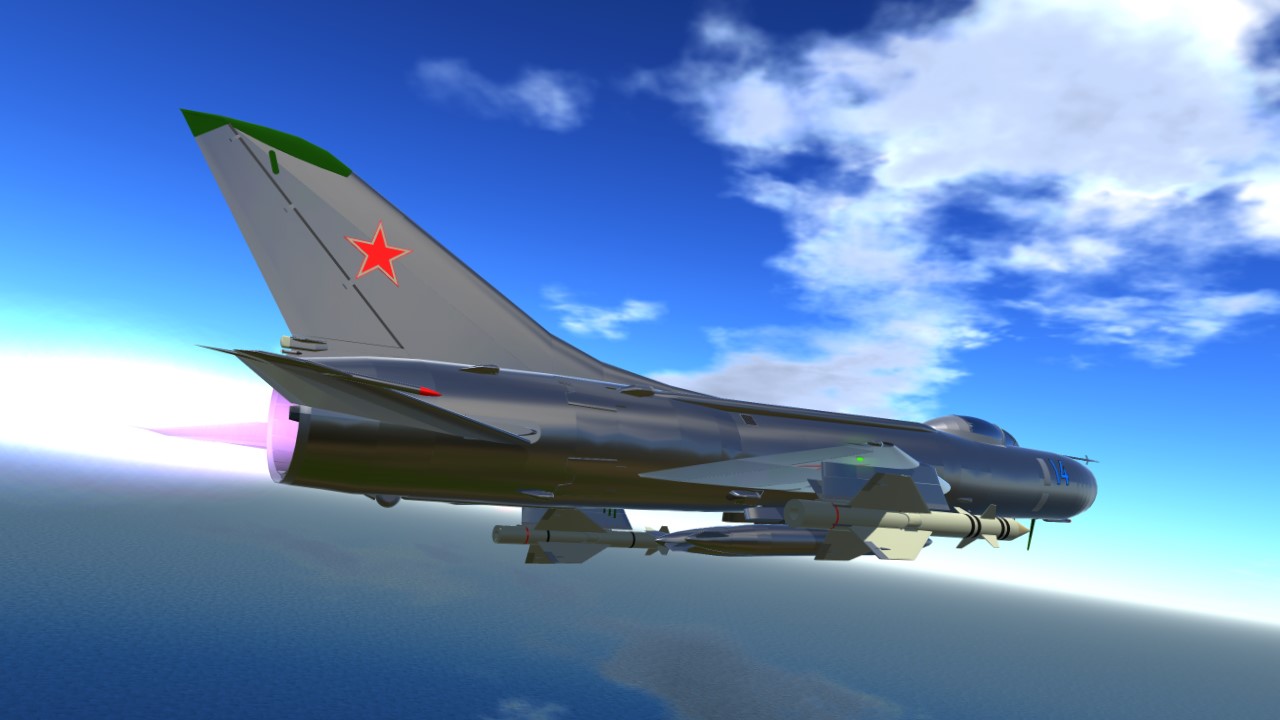
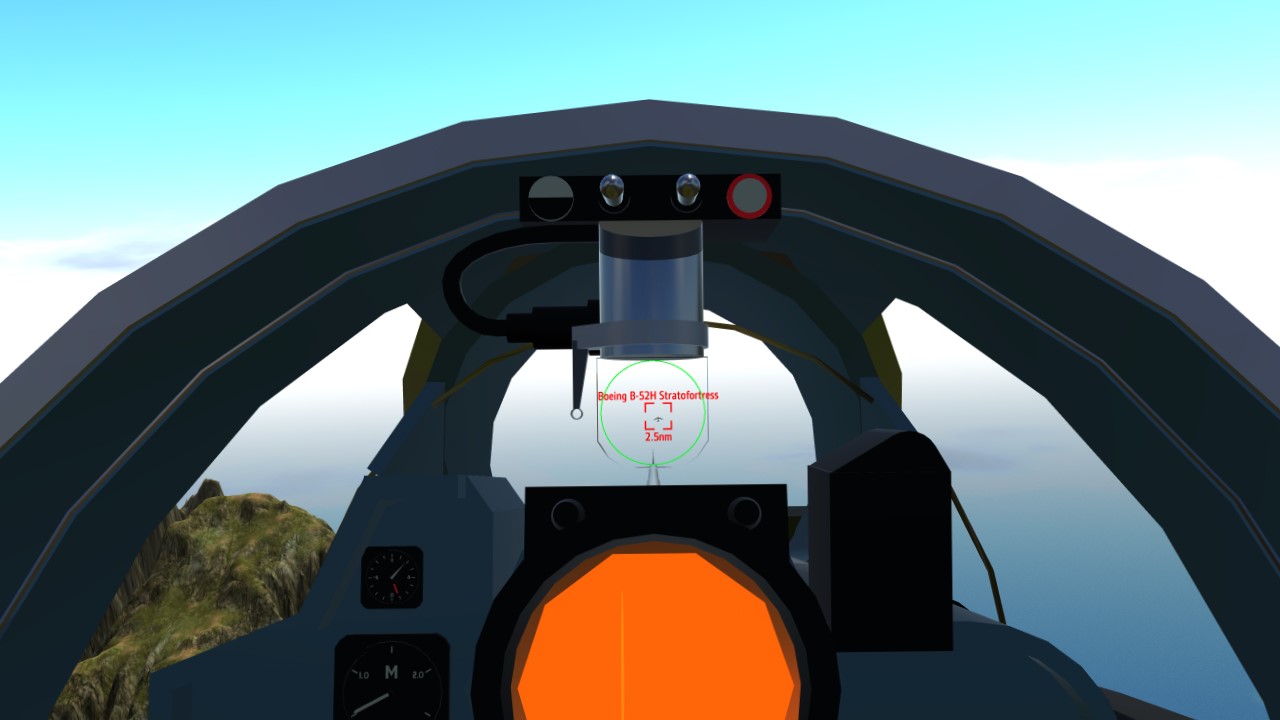
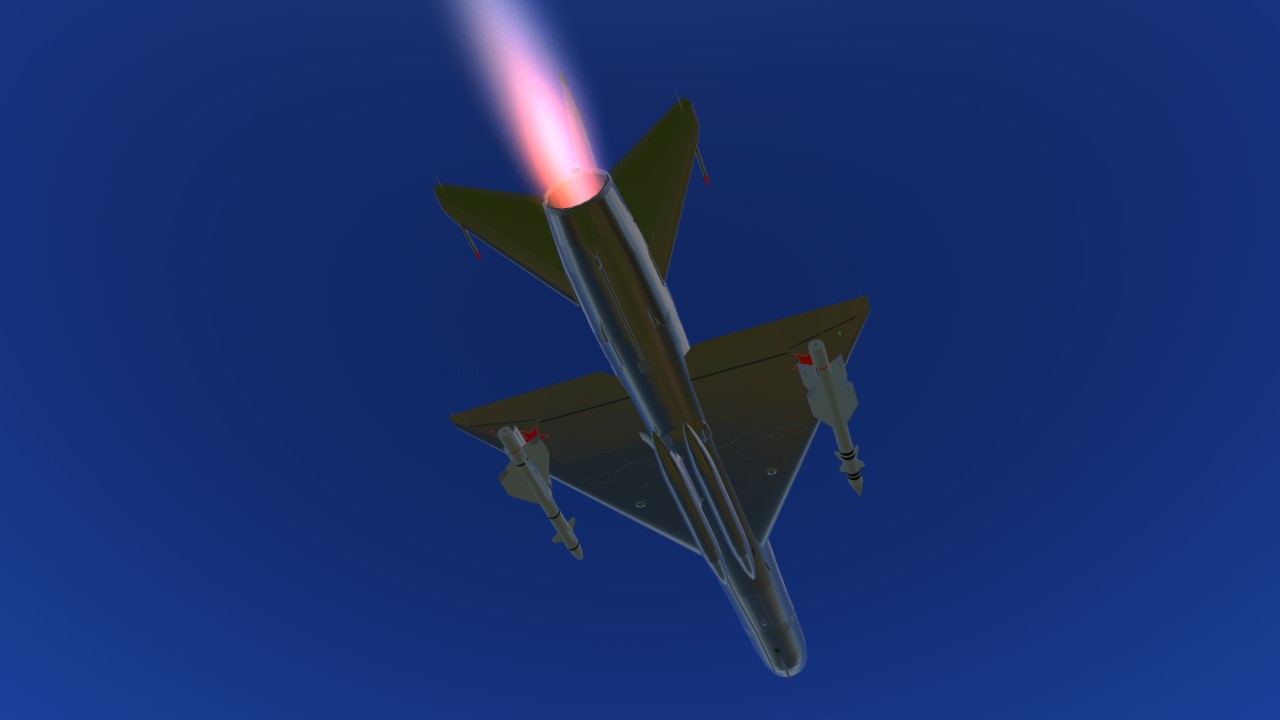
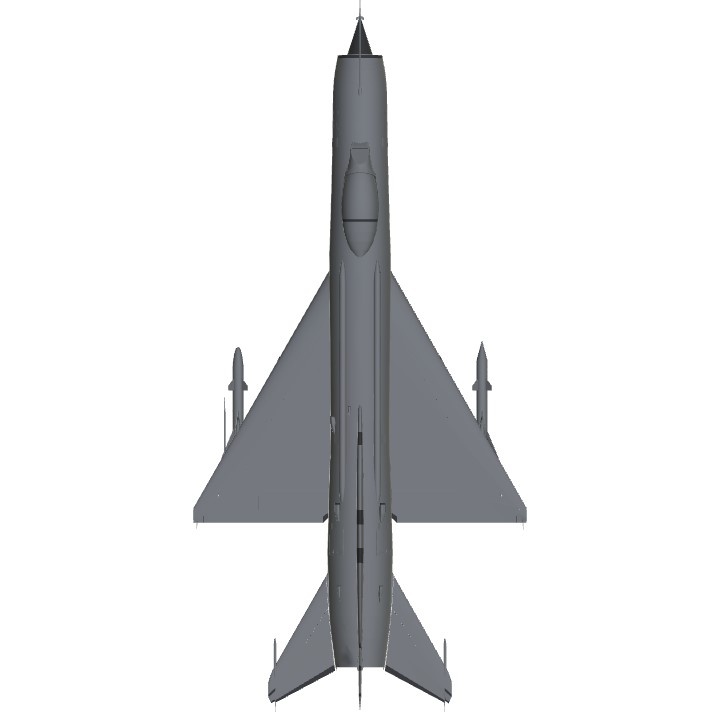
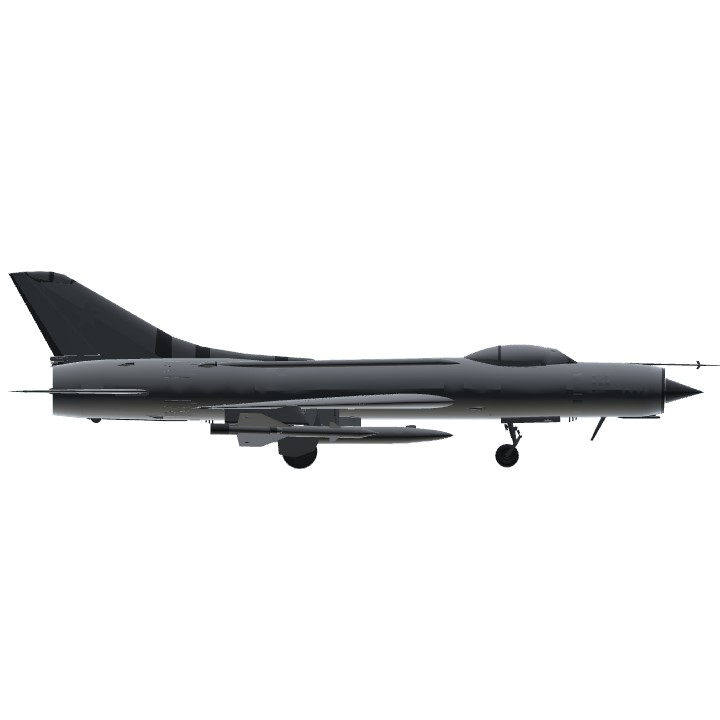
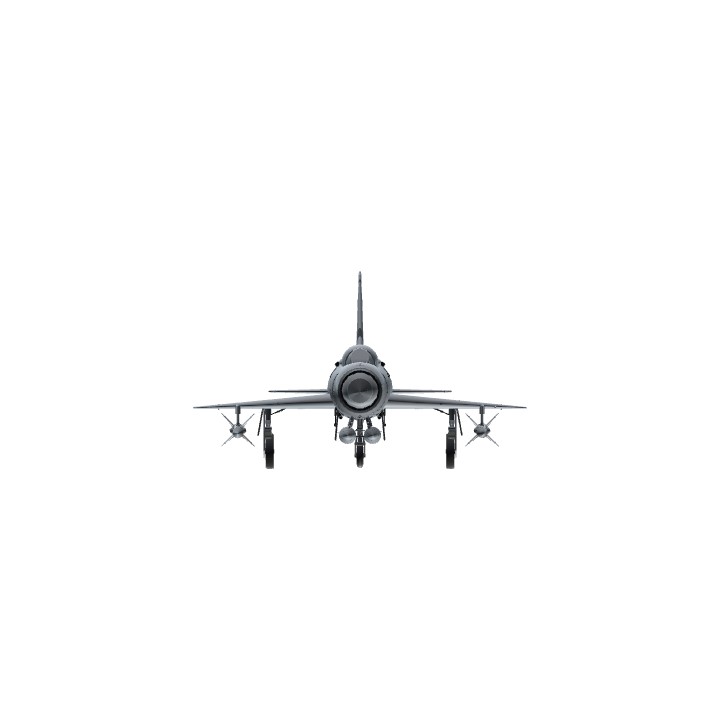
@Dimkal well, it’s an interesting point you make regarding the possibility of trim tabs on the Sukhoi-9 and 11. Research was difficult with limited sources and I ended up having to buy the definitive resource on these jets, Yefim Gordon’s “Sukhoi Interceptors”, a 320 page tome on the subject. If you mean on the horizontal stab, or really anywhere else on the jet, it was set up just like the MiG-21. TsAGI, the Soviet aerodynamics institute, the equivalent of NACA/NASA, studied the problems of high speed flight and recommended a tailed delta with a nose inlet and central shockcone as the optimal configuration for high altitude, supersonic aircraft. This is why the Su-9/11 and the MiG-21, all designed at the same time, all had the same setup, including the one piece all moving “stabilator”. Besides the textual description and photos in Gordon’s book, there was also this gem of a resource, a 500+ photo walk around of Su-11 “Red 14” in Monino air park in Russia, which clearly shows the all moving tail (if you use this resource in a future build beware, page load times are ABYSMALLY slow!). Not sure if the construction of the tail misled you or anyone else, but you can tell from the riveting what looks like a full span tab surface is fixed, though I did not find anything discussing whether or not it may have been bent up or down on the ground as a maintenance function. I doubt so as metal fatigue would have eventually broken that tab off and necessitated repairing and/or replacing that entire stab. Besides the documentation, supersonic aircraft almost never have trim tabs or elevators (the Yak-28 being the notable and puzzling exception, though I read that later Yak-28s were retrofitted with all moving tailplanes) due to the shockwave off the leading edge of the tail blanking elevators when transonic and supersonic. In the end, figuring out the physical construction of the type was difficult, but not impossible, while the flying characteristics were more of a mystery. For that, I read a lot of declassified documents from the HAVE DONUT project, when the USAF “borrowed” and tested the MiG-21, which gave a lot of specifics on flight characteristics, energy loss from the tailed delta configuration and general performance. The Su-9/11 are very similarly setup to the MiG, so I tried to model this like a bigger, heavier Fishbed with a dash of powered rudder (lacking on the MiG-21) and tried to remember that her pilots generally found the jet pleasant and responsive.
Awesome job! The attention to detail is superb. I love how you recreated the pilots experiences though the low FOV, buffeting, and accurate cockpit. Landing gear is done exceptionally well; very smooth and the suspension absorbs the hardest of landings. Shockcone movement is certainly interesting, it's amazing you were able to replicate it. I can't wait to see what you have in store next!
@Trainzo thank you.
Great build .
@SirLoafsAlot it’s ChiChiWerx #7355
yo whgats uyr discord bruh
@ChiChiWerx so, theres one thing, jamesPlanes helped me with the flight model a few hours ago so, is it ok if you can make a flight model for this one instead?
@MrShenanigansSP link?
@ChiChiWerx a tomcat B model
@MrShenanigansSP sure, what are you building?
@ChiChiWerx can you help me with a flight model?
Mach Calculator
@ChiChiWerx That would be cool
@AsteroidAsteroidTheBook I will know when I start, perhaps an A-4?
Do you have an idea what your next project will be?
Well that's nice to know. I just appreciate the quality of your builds and it would be a shame if you had never made anything again. But hey go at your own pace!@ChiChiWerx
@Hedero, maybe. It’s a lot of work and I haven’t started anything lately, so it’ll take awhile even if I started today. But I do occasionally think about what jet I would build next, a B-47, an A-4, an F-104 or a B-52 are all on the top of my potentials list.
Are you ever gonna upload an aircraft again?
@ChiChiWerx Oh yeah, i meant 4,000 lol
@AzureCorp did I mention 1,000 hrs somewhere? I looked everywhere on this post and I didn’t see where I said that. I have more than 4,000 hrs TT, not sim time, real life flying time in a variety of real aircraft.
By 1,000 hours of flight time, what do you mean by it? Simulator or real life?
@DeezDucks take a look at this one again. I made a big effort to incorporate accurate Mach effects into this build. There’s a Mach meter in the cockpit, decreased effectiveness on the horizontal tail above Mach 1.0 and the shock cone extends between Mach 1.5 and 2.2. Your build, the RL jet being optimized for high Mach numbers, in fact every high Mach jet, would benefit from incorporating Mach effects into your design. Take a look at my formulas and use what you would like.
@asteroidbook345 they're not mine, @FairFireFight built them, credit him, please.
@hRmm well, it’s a fighter sized airplane with more than 1,000 parts, not much more room to actually cram in any more details. Much of the work isn’t what you can see from the screenshots and not captured by the part count, that’s the flight model, which I spent a lot of time on and is what actually makes up the majority of the description. Just like a RL flight manual, the instructions are long and complex so that the prospective aviator knows all the ins and outs of flying the aircraft safely.
@ChiChiWerx when you try to make a plane but you make the description more detailed then the actual plane